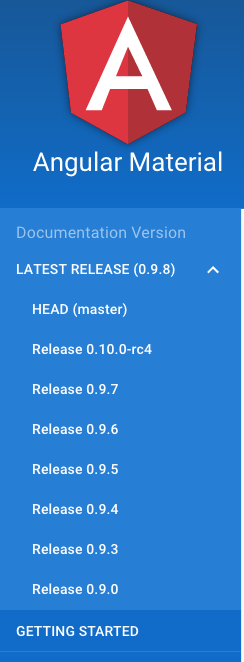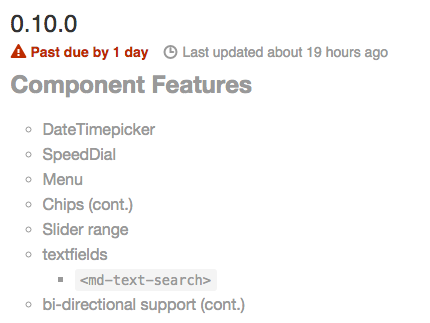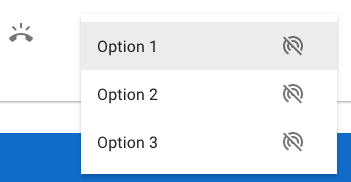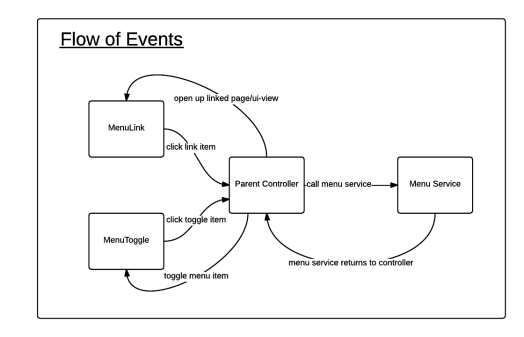Create an Angular Material style side nave menu.
For those like me who want to see the code first, then the code for this can be found in two locations.
- Github repo found here: Github Angular Material Menu
- Working Plunker found here: Plunker
ngMaterial Menu
Backstory
Ever since Angular Material came out I have been watching and waiting for the neat side navigation menu on their site 
I was always like "when am I going to be able to have this in my sites"? What I thought was an answer to the above question was only a big

But

Ok, so what do you do?
You make your own.
So I spent the most time piecing together what they have on their site and making custom directives out of the code. It wasn't all that bad, and instead of you having to go through this again I will explain the teardown and rebuild of their side nav/menu bar.
Overview
A bit of a disclaimer here, as well as, some assumptions. I use
Start with the Structure of Menu Items and Sub-items
You want to start with the structure of your menu. In my example, I have 'Getting Started', 'Beers', and 'Munchies' as my top menu items. Out of these menu items I only want 'Beers' and 'Munchies' to have sub-items, so I added some types of beers and munchies which will become the sub-item list. Once we have a basic idea for a menu with/without sub-items we can put it into an Angular factory/service using a structure that mirrors that structure.
Menu Factory/Service
The factory is a simple service that holds the information for what goes
Menu Structure
The object for storing sections
sections.push({
name: 'Beers',
type: 'toggle',
pages: [{
name: 'IPAs',
type: 'link',
state: 'beers.ipas',
icon: 'fa fa-group'
}, {
name: 'Porters',
state: 'home.toollist',
type: 'link',
icon: 'fa fa-map-marker'
},
{
name: 'Wheat',
state: 'home.createTool',
type: 'link',
icon: 'fa fa-plus'
}]
});
Properties
If you noticed there were a couple of explanations needed for example typestateicon
Menu Directives
So there are only two directives used here. First, there is a beers.ipa state.
Menu Toggle
The Directive
The
var controller = $element.parent().controller();
a. this line of code allows us to get a handleof theparents controller. We need the parent controller because we will be calling functions in the parent controller on behalf of this directive.
.directive('menuToggle', [ '$timeout', function($timeout){
return {
scope: {
section: '='
},
templateUrl: 'partials/menu-toggle.tmpl.html',
link: function($scope, $element) {
var controller = $element.parent().controller();
$scope.isOpen = function() {
return controller.isOpen($scope.section);
};
$scope.toggle = function() {
controller.toggleOpen($scope.section);
};
}
};
}])
The Template
I put the template in the Angular's template cache (
<md-button class="md-button-toggle" ng-click="toggle()"
aria-controls="side-menu-" flex layout="row" aria-expanded="">
<span aria-hidden="true" class="pull-right fa fa-chevron-down md-toggle-icon" ng-class="{\'toggled\' : isOpen()}"></span>
</md-button>
<ul ng-show="isOpen()" id="side-menu-" class="menu-toggle-list">
<li ng-repeat="page in section.pages">
<menu-link section="page"></menu-link>
</li>
</ul>
There are a couple interesting things here.
<ul ng-show="isOpen()" ...is where the menu knows to open or close. If we look back to the directive snippet we can see thatisOpen()actually calls the parent's controller functionisOpen()
$scope.isOpen = function() {
return controller.isOpen($scope.section);
};
<li ng-repeat="page in section.pages"><menu-link section="page"></menu-link></li>
a. thispeice of HTML is used to indicate we want to also include the menuLinkdirective for each menu item's sub categories.
MenuLink Directive
This directive is for when ttypelink within your menu structure.
For example:
{ name: 'IPAs',
type: 'link',
state: 'beers.ipas',
icon: 'fa fa-group'
}
The Directive
.directive('menuLink', function () {
return {
scope: {
section: '='
},
templateUrl: 'partials/menu-link.tmpl.html',
link: function ($scope, $element) {
var controller = $element.parent().controller();
$scope.focusSection = function () {
// set flag to be used later when
// $locationChangeSuccess calls openPage()
controller.autoFocusContent = true;
};
}
};
})
This is a pretty simple directive with a linking function only around 10 lines of code. The functionality is within the template, so here it is.
The Template
<md-button ng-class="{\'\' : true}" ui-sref-active="active" ui-sref="" ng-click="focusSection()">
<span class="md-visually-hidden" ng-if="isSelected()">current page</span></md-button>
Basically, this will create a menu item that is not of type:'toggle' which is just a link. This directive is used for both
The Parent Controller
The parent controller and its template menuTogglemenuLink directives, and it serves as sort of a middle man between the directives and the menu service. Every time something happens in emenuTogglemenuLink directives there is a reaction that is fired type: 'toggle'. This click event is captured imenuToggle directive and then, in result, it calls the parent controller's function which, in turn, calls the menu service's function which then sends back the information to display the clicked menu item's sub items.
.controller('HomeCtrl', [
'$rootScope',
'$log',
'$state',
'$timeout',
'$location',
'menu',
function ($rootScope, $log, $state, $timeout, $location, menu) {
var vm = this;
var aboutMeArr = ['Family', 'Location', 'Lifestyle'];
var budgetArr = ['Housing', 'LivingExpenses', 'Healthcare', 'Travel'];
var incomeArr = ['SocialSecurity', 'Savings', 'Pension', 'PartTimeJob'];
var advancedArr = ['Assumptions', 'BudgetGraph', 'AccountBalanceGraph', 'IncomeBalanceGraph'];
//functions for menu-link and menu-toggle
vm.isOpen = isOpen;
vm.toggleOpen = toggleOpen;
vm.autoFocusContent = false;
vm.menu = menu;
vm.status = {
isFirstOpen: true,
isFirstDisabled: false
};
function isOpen(section) {
return menu.isSectionSelected(section);
}
function toggleOpen(section) {
menu.toggleSelectSection(section);
}
}])
The Template for Parent Controller
The template really only has one important note. The HTML:
<li ng-repeat="section in vm.menu.sections" class="parent-list-item"
ng-class="{'parentActive' : vm.isSectionSelected(section)}">
<h2 class="menu-heading" ng-if="section.type === 'heading'"
id="heading_">
</h2>
<menu-link section="section" ng-if="section.type === 'link'"></menu-link>
<menu-toggle section="section" ng-if="section.type === 'toggle'"></menu-toggle>
</li>
This section of html allows the menu structure you created above to be created. These 5 lines loop through your menu sections and identifies which sections/pages are links or toggles.
For Example:
sections.push({
name: 'Beers',
type: 'toggle',
pages: [{
name: 'IPAs',
type: 'link',
state: 'beers.ipas',
icon: 'fa fa-group'
}, {
name: 'Porters',
state: 'home.toollist',
type: 'link',
icon: 'fa fa-map-marker'
},
{
name: 'Wheat',
state: 'home.createTool',
type: 'link',
icon: 'fa fa-plus'
}]
});
The above snippet will create a Beers toggleable menu item with 3 menu sub items all which are links to their individual states. This example will have this as a result:

The Complete Parent Template
The above snippet is the complete parent template that contains both tmenuLinkmenuToggle directives.
<div layout="row">
<div>
<md-sidenav class="md-sidenav-left md-whiteframe-z1" md-component-id="left" md-is-locked-open="$mdMedia('gt-sm')">
<md-toolbar md-scroll-shrink>
<div class="md-toolbar-tools">
<h3>
<span>My App Title</span>
</h3>
</div>
</md-toolbar>
<md-content flex role="navigation">
<ul class="side-menu">
<li ng-repeat="section in vm.menu.sections" class="parent-list-item"
ng-class="{'parentActive' : vm.isSectionSelected(section)}">
<h2 class="menu-heading" ng-if="section.type === 'heading'"
id="heading_">
</h2>
<menu-link section="section" ng-if="section.type === 'link'"></menu-link>
<menu-toggle section="section" ng-if="section.type === 'toggle'"></menu-toggle>
</li>
</ul>
</md-content>
</md-sidenav>
</div>
</div>
Diagram
If the above description didn't help here is another explanation of what is happening between the parent controller, the directives, and the service. First, start with either clicking on the menuLinkmenuToggle menu items then follow the flow through either then menu item toggling, or the menu link's page/

Conclusion
Hope this was helpful. Let me know any upgrades/updates I can make to this to improve it, as I know it needs some massaging. I just wanted to get this out, so anyone who is stuck will find this useful. Also, let me know if you think my blog post needs some more infomation to help you all.
Do you have Enterprise Fullstack / Javascript consulting requirements? Contact us today to schedule a complimentary consultation, or check out our Enterprise Fullstack service offerings.




